Jarviss PHYSICAL EXAMINATION & Health Assessment
AUSTRALIAN AND NEW ZEALAND EDITION
Clare Cole, RN, BN, Grad Cert Nurs (Ortho), MEdSt, MRCNA
Lecturer/Academic, University of Ballarat, VIC, Australia
Olivia Hill, BN(Hons)
Lecturer (Master of Nursing Science), The University of Western Australia, WA, Australia
Rosemary Saunders, RN, MPH, PGDipHlthProm, BAppSc, MRCNA
Course Coordinator (Master of Nursing Science), The University of Western Australia, WA, Australia
SAUNDERS
Copyright
 Saunders is an imprint of Elsevier
Saunders is an imprint of Elsevier
Elsevier Australia. ACN 001 002 357
(a division of Reed International Books Australia Pty Ltd)
Tower 1, 475 Victoria Avenue, Chatswood, NSW 2067
2012 Elsevier Australia
This publication is copyright. Except as expressly provided in the Copyright Act 1968 and the Copyright Amendment (Digital Agenda) Act 2000, no part of this publication may be reproduced, stored in any retrieval system or transmitted by any means (including electronic, mechanical, microcopying, photocopying, recording or otherwise) without prior written permission from the publisher.
Every attempt has been made to trace and acknowledge copyright, but in some cases this may not have been possible. The publisher apologises for any accidental infringement and would welcome any information to redress the situation.
This publication has been carefully reviewed and checked to ensure that the content is as accurate and current as possible at time of publication. We would recommend, however, that the reader verify any procedures, treatments, drug dosages or legal content described in this book. Neither the author, the contributors, nor the publisher assume any liability for injury and/or damage to persons or property arising from any error in or omission from this publication.
National Library of Australia Cataloguing-in-Publication Data
Jarvis, Carolyn.
Jarviss physical examination & health assessment : pocket companion/by Carolyn Jarvis; Australian adapting editors: Clare Cole, Olivia Hill and Rosemary Saunders.
Australian and New Zealand ed.
9780729539753 (pbk.)
Includes bibliographical references and index.
Physical diagnosisHandbooks, manuals, etc.
Nursing assessment--Handbooks, manuals, etc.
Cole, Clare.
Hill, Olivia.
Saunders, Rosemary.
616.0754
Publisher: Libby Houston
Developmental Editor: Elizabeth Coady
Publishing Services Manager: Helena Klijn
Project Coordinator: Lisa Shillan
Edited by Sybil Kesteven
Proofread by Sarah Newton-John
Cover design by Lisa Petroff
Internal design and typesetting by Midland Typesetters, Australia
Index by Cynthia Swanson
Printed in China by tbc
Preface
The first ANZ edition of Pocket Companion for Physical Examination and Health Assessment is designed for two groupsthose who need a practical clinical reference and those acquiring beginning assessment skills. The Pocket Companion is useful for examination sequencing, when learning new techniques or working in different clinical areas.
The ANZ edition of the Pocket Companion aligns with Jarviss Physical Examination & Health Assessment ANZ edition and is an ideal quick reference guide for students or nurses to carry with them in the clinical setting. The essential steps for health assessment are presented in an easy to use, two-column format, which highlights the contrast between normal and abnormal findings. Clear explanation, accompanied by extensive diagrams and photos of examination techniques, provides a valuable and reassuring reference to both students and nurses.
The Pocket Companion has been adapted in line with the adaptation of the parent text, the first ANZ edition of Jarviss Physical Examination and Health Assessment. For those times when readers need detailed coverage of a particular technique or finding, it is easily found through numerous cross-references to the parent text.
Key features of the Pocket Companion:
interviewing, health history and assessment techniques are outlined.
system chapters are ordered by
anatomy overview
subjective data
objective data
abnormal findings for advanced practice, where relevant
cultural and social considerations, where relevant.
developmental considerations, where relevant.
summary checklists for each chapter
integration of the complete physical examination.
Acknowledgments
The adapting editors would like to thank the following people:
the Elsevier team for the opportunity to undertake this adaptation; specifically Elizabeth Coady, Libby Houston, Sybil Kesteven and Lisa Shillan for facilitating the entire process
the reviewers for their useful feedback which helped to shape the Pocket Companion
the authors of the ANZ edition of Jarviss Physical Examination & Health Assessment, Elizabeth Watt and Helen Forbes, for their feedback and guidance
our employers at The University of Western Australia and the University of Ballarat.
Reviewers
Trish Burton, DipAppSc, BSc, BAppSc, MEd, PhD
Senior Lecturer, School of Nursing and Midwifery, Victoria University, VIC, Australia
Helen Forbes, RN, BAppSc (Adv Nurs), MEdStudies, PhD
Director of Teaching and Learning, School of Nursing and Midwifery, Deakin University, VIC, Australia
Martin Owen, RPN, RN, CCNC, DipNurs, BN(Hons)
Lecturer in Nursing, Deakin University, VIC, Australia
Jennifer Rabach, RN, BAppSci(AdvNsg), MEd, FRCNA
Lecturer and International Coordinator, Victoria University, VIC, Australia
Elizabeth Watt, RN, RM, DipN, BAppSc (Adv Nurs), MNS, Cert Prom Cont, FRCNA
Head, Clinical School of Nursing at Austin Health, Division of Nursing & Midwifery, La Trobe University, VIC, Australia
Mandy Williams, RN (UK), RN (NZ) MHS (Health Professional Education)
BlendEd Learning Coordinator, Waiariki Institute of Technology, Rotorua, New Zealand
Inside Front Cover
Throughout this text we have used JF&W to refer to Jarvis, Forbes & Watt: Jarviss Physical examination and health assessment
2012, Sydney, Elsevier Australia
Chapter One The health assessment interview and the health history
The health history is important in beginning to identify the persons health strengths and problems and as a bridge to the next step in data collection, the physical examination.
The health history collects subjective data, what the person says about themselves. This is the first and the best chance a person has to tell you what they perceive their health state to be.
PREPARATION FOR THE INTERVIEW
An important part of the interview is the preparation of the physical setting where the interview is to occur. The setting may be in the community, in a clinic or the persons home, or in a hospital. The following factors need to be considered before commencing the interview.
Ensure privacy.
Aim for geographical privacya private room. If geographical privacy is not available, the psychological privacy afforded by curtained partitions may suffice as long as the person feels sure no one can overhear the conversation or interrupt.
Refuse interruptions.
You need this time to concentrate and to establish rapport therefore inform any support staff about the interview, and ask that they not interrupt you during this time. Discourage other health professionals from interrupting you during the interview.


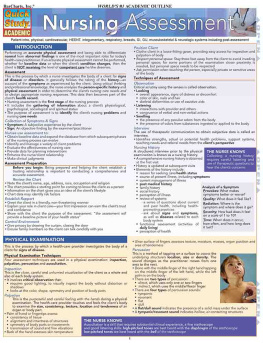
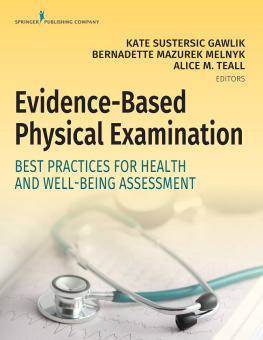
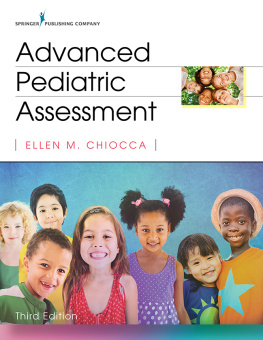
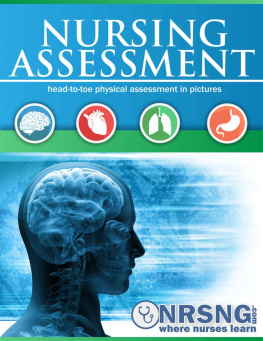
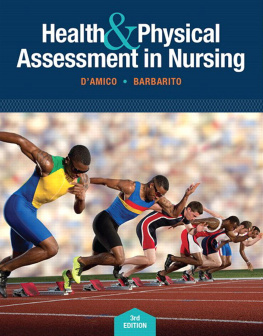
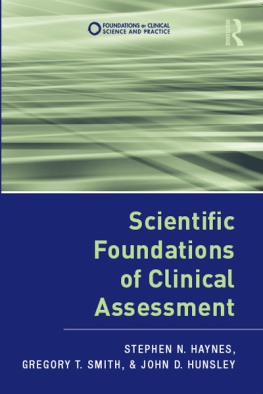
 Saunders is an imprint of Elsevier
Saunders is an imprint of Elsevier